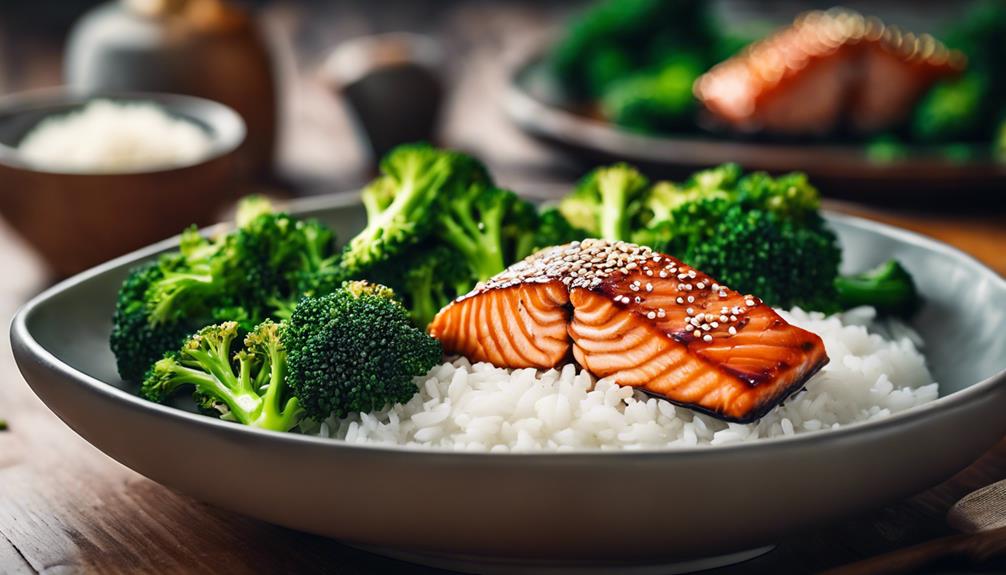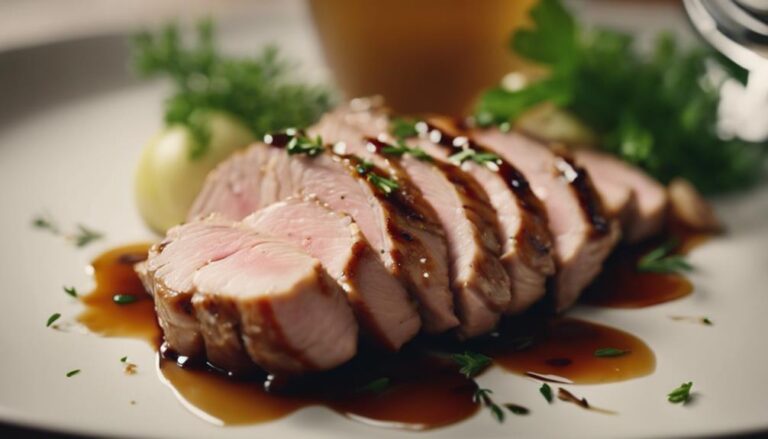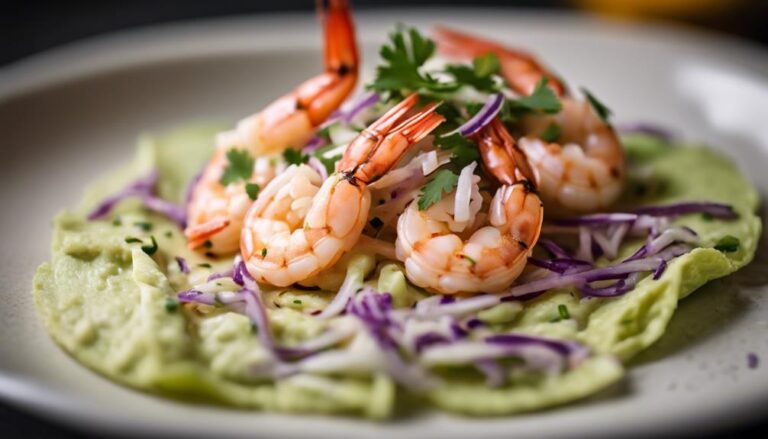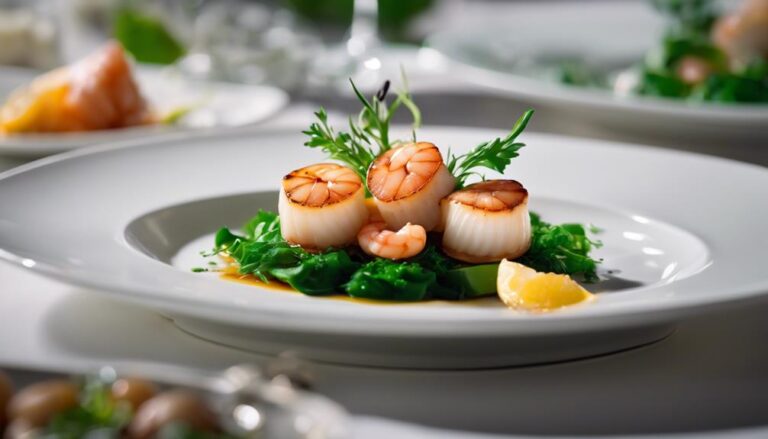Sous Vide Teriyaki Salmon Bowls With Broccoli and Rice
Intrigued by the idea of Sous Vide Teriyaki Salmon Bowls? Picture perfectly cooked salmon, guaranteed in savory teriyaki sauce, served with crisp broccoli and fluffy rice. The sous vide method guarantees salmon is tender and bursting with flavor. The teriyaki sauce adds a sweet, tangy twist that complements the richness of the salmon. The combination of textures and tastes is a true delight for your palate. Ready to savor this culinary delight?
What You Will Learn Here
- Sous vide ensures perfectly cooked, tender salmon with teriyaki infusion.
- Broccoli adds nutrients and color, complementing the umami flavors.
- Rice provides a satisfying base for the dish, absorbing teriyaki sauce.
- Minimal hands-on time required for a flavorful and hassle-free meal.
- Balanced textures and flavors create a harmonious dining experience.
Origin of Teriyaki Sauce
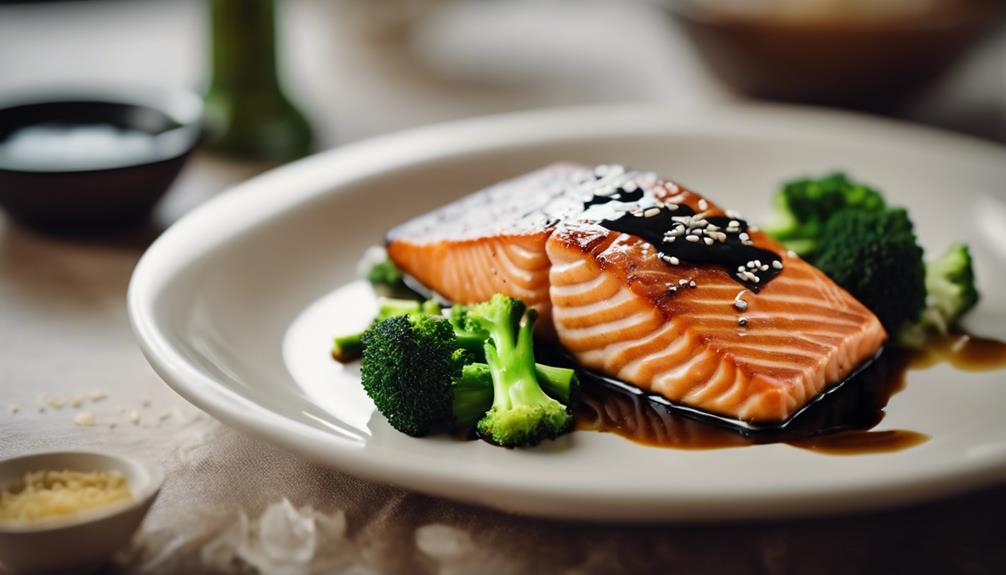
Teriyaki sauce, a staple in Japanese cuisine, boasts a rich history and a mouthwatering blend of soy sauce, mirin, and sugar.
The glossy sheen that coats grilled or broiled meats is a reflection of the sauce's name, derived from 'teri' for luster and 'yaki' for grill or broil.
Its versatile nature and irresistible mix of flavors have propelled teriyaki sauce to global fame, making it a must-have condiment in kitchens worldwide.
Teriyaki Sauce Ingredients
First crafted in Japan, the renowned teriyaki sauce blends mirin, soy sauce, and sugar to create its signature flavor profile. This flavorful combination of ingredients provides a perfect balance of sweetness and saltiness, ideal for enhancing the taste of dishes like salmon. The word 'teriyaki' itself reflects the sauce's essence – a glossy, grilled finish that adds depth to the dish. Traditional recipes may also include additional elements such as vinegar, ginger, or garlic for a more complex taste. Below is a table highlighting the primary ingredients in teriyaki sauce and their roles in elevating the overall flavor profile:
| Ingredient | Role |
|---|---|
| Mirin | Adds sweetness |
| Soy Sauce | Provides umami |
| Sugar | Balances flavors |
| Vinegar | Adds tanginess |
| Ginger | Infuses freshness |
Teriyaki Sauce History
Originating in the culinary traditions of Japan, the genesis of teriyaki sauce can be traced back to a harmonious fusion of key ingredients that tantalize the taste buds with a perfect blend of sweetness and umami.
The name itself, derived from 'teri' meaning luster and 'yaki' meaning grilled or broiled, reflects its traditional use as a glaze for fish like salmon, imparting both flavor and a glossy finish.
The classic combination of soy sauce, mirin, and sugar forms the base of this sauce, offering a delightful balance of sweet and savory notes. As its popularity transcended borders, teriyaki sauce underwent global reinterpretations, incorporating additional elements such as garlic, ginger, and vinegar to enhance its complexity.
Today, teriyaki sauce remains a versatile culinary companion, elevating dishes with its rich history and diverse flavor profile.
Teriyaki Sauce Cooking Tips
Tracing the culinary evolution of teriyaki sauce reveals a rich tapestry of flavors and techniques that have captivated palates worldwide.
The origin of teriyaki sauce in Japan, with its key ingredients of mirin, soy sauce, and sugar, has made it a beloved condiment for marinating meats like salmon.
The name 'teriyaki' itself, derived from 'teri' meaning shine and 'yaki' meaning grill or broil, perfectly encapsulates the glossy finish it imparts on dishes.
When preparing teriyaki sauce, consider customizing it with vinegar, garlic, or ginger to enhance its depth of flavor.
This versatile sauce isn't only ideal for salmon but also elevates the taste of chicken, tofu, or vegetables, making it a must-have in your culinary repertoire.
Teriyaki Sauce Key Components

Crafting a delectable teriyaki sauce hinges on harmonizing the key components of mirin, soy sauce, and sugar to achieve a perfect blend of sweet, savory, and umami flavors. The importance of these ingredients is vital in creating a sauce that elevates the flavor profile of dishes like Teriyaki Salmon.
To enhance the complexity of your teriyaki sauce, consider incorporating additional ingredients such as vinegar, minced ginger, or garlic. These additions can add depth and layers of flavor to your sauce, making it stand out in your dish.
Teriyaki Salmon Variations
When it comes to teriyaki salmon variations, think beyond the traditional teriyaki sauce and rice combo. Consider trying salmon marinated in miso for a rich umami flavor, or opt for miso-glazed salmon fillets for a more intense taste.
Another option could be salmon with a honey glaze, offering a sweet and savory twist to the classic dish.
Salmon Marinated in Miso
Marinating your salmon in miso presents a tantalizing way to enhance its flavor profile, infusing it with a rich umami depth that perfectly complements the sweet and savory notes of teriyaki sauce. When exploring the world of miso-marinated salmon, consider the following:
- Umami Boost: Miso adds a unique umami flavor profile that elevates the taste of the salmon.
- Tenderization: The enzymes in miso help to tenderize the salmon, resulting in a moist and flavorful dish.
- Complexity: Combining miso with teriyaki sauce creates a depth of flavors that will impress your taste buds.
Experimenting with miso marinades can take your teriyaki salmon to new heights, offering a delightful fusion of traditional Japanese flavors.
Miso-Glazed Salmon Fillets
Enhance your culinary repertoire by exploring the savory twist of Miso-Glazed Salmon Fillets, a delightful variation of traditional teriyaki salmon recipes. The miso glaze offers a unique depth of flavor, infusing the salmon with a rich umami taste that sets it apart from the classic teriyaki flavor profile. This combination of miso and salmon creates a delicious and satisfying meal that's sure to impress your taste buds. Miso-Glazed Salmon Fillets are a popular choice for those seeking a flavorful alternative to traditional teriyaki preparations.
- Miso-Glazed Salmon Fillets provide a rich umami taste to the dish.
- Miso, a fermented soybean paste, enhances the depth of flavor in the salmon.
- The fusion of miso and salmon creates a delectable and fulfilling meal experience.
Salmon With Honey Glaze
The irresistible combination of honey-glazed salmon offers a delightful balance of sweet and savory flavors that elevate the natural richness of the fish. When preparing glazed salmon on a sheet pan, the caramelization process enhances the taste and presentation, making it a visually appealing dish.
The honey-soy sauce-garlic glaze creates a sticky, spicy, and gingery coating on the salmon fillets, adding complexity to each bite. This dish isn't only quick and easy to prepare but also versatile, suitable for both everyday meals and special occasions.
With its perfect harmony of sweet and savory elements, honey-glazed salmon is sure to be a crowd-pleaser at any dining table.
- Caramelization process enhances flavor and presentation
- Versatile dish for any occasion
- Perfect balance of sweet and savory flavors
Salmon Searing Technique Secrets
When searing salmon, you want to achieve a mouthwatering crust that locks in all the juicy flavors.
The key to success lies in maintaining a high heat to get that perfect golden-brown color.
Searing for Flavor
For a tantalizing burst of flavor and texture, searing your salmon is a crucial step that elevates your dish to new heights. Searing creates a golden crust on the salmon, adding a delightful crunch to each bite. The Maillard reaction that occurs during searing not only enhances the taste but also gives the salmon a beautiful appearance.
Additionally, searing caramelizes the sugars in the teriyaki sauce, intensifying its sweet and savory flavors. When seared properly, the salmon retains its moisture and juiciness while developing a crispy exterior that contrasts perfectly with the tender flesh. To achieve best results, sear your salmon on a hot pan with a thin sheet of oil, starting with the skin-side down.
Temperature Control Tips
Achieving the perfect sear on your salmon fillets requires precise temperature control within the ideal range of 50C-60C when using sous vide cooking techniques. Maintaining this temperature range guarantees that your salmon retains its moisture and delicate texture while developing a beautiful crust.
When searing salmon sous vide, the controlled heat allows for even cooking throughout the fillet, eliminating the risk of overcooking or drying out. Using a reliable sous vide machine is key to controlling the exact temperature needed for tender and flaky salmon.
Achieving Perfect Caramelization
To achieve perfect caramelization on your salmon, make sure the pan is preheated until hot to create a desirable sear. Searing your salmon at high heat is a quick and easy way to guarantee moisture is locked in and develop a crispy crust that adds depth to your dish.
A thin layer of oil in the pan not only prevents sticking but also assists in browning the salmon beautifully. Before searing, patting the salmon dry with paper towels ensures a good Maillard reaction, enhancing the flavor profile.
Allow the salmon to cook undisturbed for a few minutes on each side to achieve that golden brown color and flavorful crust that will elevate your dish to the next level.
Final Thoughts
In conclusion, these Sous Vide Teriyaki Salmon Bowls provide a flavorful and hassle-free way to enjoy a perfectly cooked and well-balanced meal. The precision of sous vide cooking guarantees that the salmon fillets are tender and cooked to perfection, while the infusion of teriyaki sauce adds a delicious umami flavor profile. The convenience of this recipe can't be overstated; with minimal hands-on time, you can achieve a restaurant-quality dish in the comfort of your own home.
The marriage of teriyaki salmon, nutrient-rich broccoli, and satisfying rice in a single bowl creates a harmonious blend of textures and flavors. The sous vide method allows the teriyaki sauce to permeate the salmon, enhancing its taste and creating a mouthwatering experience with every bite. Whether you're seeking a quick weeknight meal or an impressive dish to serve guests, these Sous Vide Teriyaki Salmon Bowls are sure to delight your taste buds and satisfy your hunger. Experience the ease and deliciousness of this recipe for a delightful dining experience.
Frequently Asked Questions
How Long Does It Take to Sous Vide Salmon?
When you sous vide salmon, the timing varies depending on thickness. Sous vide techniques guarantee precise cooking for perfect salmon doneness and texture. It's a moist and tender experience, with flavors sealed in.
What to Serve With Teriyaki Fish?
When serving teriyaki fish, think about side dishes that complement its sweet and savory flavors. Consider stir-fried veggies or pickled radishes for a contrast. Add a squeeze of lemon for brightness. Garnish with sesame seeds or green onions for extra flavor and texture.
How Many Calories in a Teriyaki Salmon Poke Bowl?
To find out the calorie count of a teriyaki salmon poke bowl, check the nutritional information on the ingredients used. Factors like rice, salmon, teriyaki sauce, and toppings influence the calories. Making lighter choices can help manage caloric intake.
How Many Calories Are in Salmon Rice and Broccoli?
When combining salmon, rice, and broccoli, the nutritional breakdown showcases a balanced mix of protein, carbs, and vitamins. Portion control is crucial for managing calorie intake. Enjoying this dish guarantees a nourishing and satisfying meal.
Conclusion
Enjoy the delectable tastes of sous vide teriyaki salmon bowls with broccoli and rice.
The tender salmon, imbued with the rich flavors of teriyaki sauce, pairs perfectly with the fresh crunch of broccoli and fluffy rice.
The searing technique guarantees a crispy exterior while preserving a moist and flaky interior.
This dish is a delightful balance of savory, sweet, and umami flavors that will leave you yearning for more. Bon appétit!
